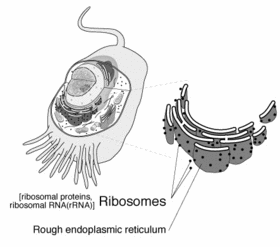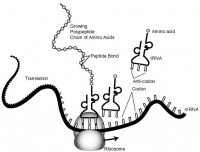Ribosome
The Ribosome are molecular machines responsible for catalyzing the synthesis of proteins. These cellular organelles are ubiquitous, found in both prokaryotes and eukaryotes. Protein synthesis is extremely important to all cells, and therefore a large number of ribosomes—sometimes hundreds or even thousands—can be found throughout a cell.[1]
Ribosomes float freely in the cytoplasm and are sometimes bind to another organelle called the endoplasmic reticulum. They are a large catalytic complex composed of structural RNA and about 80 different proteins. In its inactive state, it exists as two subunits: a large subunit and a small subunit, each having a different function during protein synthesis.[1]
Activity
Their catalytic activity involves the conversion of the genetic instructions carried by an mRNA into amino acids and the condensation reaction which creates the peptide bond between their amino and carboxyl group. The process of converting an mRNA's genetic code into the exact sequence of amino acids that make up a protein is called translation.[1]
When the small subunit encounters an mRNA, the process of translating an mRNA to a protein begins. In the large subunit, there are two sites for amino acids to bind and thus be close enough to each other to form a bond. The "A site" accepts a new transfer RNA, or tRNA—the adaptor molecule that acts as a translator between mRNA and protein—bearing an amino acid. The "P site" binds the tRNA that becomes attached to the growing chain.[1]
References
- ↑ 1.0 1.1 1.2 1.3 What is a Cell? by the National Center for Biotechnology Information.



